
| Home | Source Reduction | Friends of Green Friends | Newsletters |
| Gardening | Resources | What You Can Do | Embracing The Trees |
|
Repair and Reuse |
|
In 2017, a bracelet that I had blessed by Amma broke. It was a small jade bangle, like the one Amma sometimes used to wear. I was very sad and did not want to throw it away. I decided that I needed to both fix it and be careful with it in the future, so as not to break it again. Things break, but with some care and love, we can sometimes fix them. |
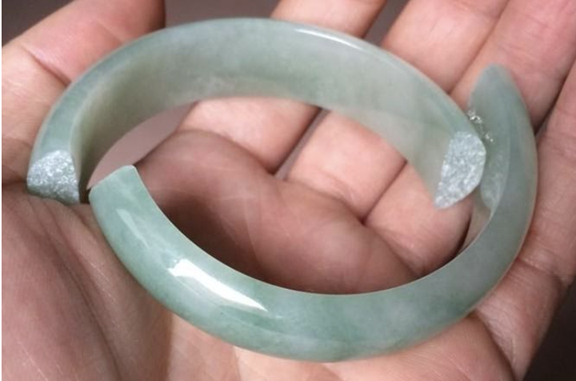 |
| On doing some research, I found an epoxy glue that can help attach non-porous things together. Using epoxy and tape to serve as an overnight clamp, I glued the bracelet back together strongly! Given this lesson from Amma on repairing items through Her bracelet, I’ve tried to fix many more things around the home that I previously thought were not fixable.
Below, I am sharing some ideas on how we can repair items around the house to extend their lives and prevent waste. GreenFriends has previously published a lot about buying used items, so I will not discuss that much below. Instead, I will focus on a few ideas for extending the life and use of what we do have - specifically, clothing, furniture, jewelry, dinnerware and plastic items - with the hope that these tricks can apply to other items you might want to repair! |
|
Clothes Many of you may know that our Amma is wonderful at sewing. She sewed many face masks during the pandemic, and many ashramites and villages that Amma helps, engage in sewing as seva and trade. Although sewing clothes from scratch and raw materials may be difficult, sewing to repair and resize clothes is less difficult. |
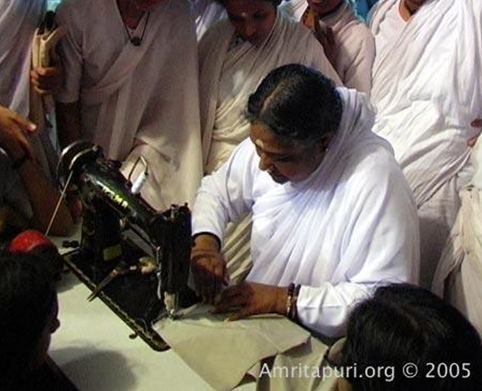 Amma sewing as seva after the 2005 Tsunami |
|
When we find holes in clothing, often we may be able to patch them using store-bought patches; just lay the patch behind the hole and use a needle and thread to stitch it onto the clothing. You can also find iron-on patches online or possibly at the grocery store in the section that carries light-bulbs and safety pins. Patchwork clothing is in style these days, and you can even buy heart or animal shaped patches to plug up holes. Alternatively, you could cover a hole by using simple stitches in a matching thread color so it’s not as visible. To patch holes in woolen items, you could use a product called Woolfiller. It comes in multiple colors and does not require any knitting. When mending rips or holes, if the fabric is too thin and developed a hole because it was very thin, a hole might pop up again and possibly in a different spot. In such cases, it may be best to reuse or responsibly dispose of the item. To reuse, clothes could be turned into mops or kitchen rags. If you have a sewing machine, which could be a handy tool to have around - even a simple, inexpensive second-hand sewing machine will work - you can "finish" or fold up the edges of the cut pieces to make nice looking kitchen rags. To dispose fabric responsibly, if it’s a piece of clothing made of natural fiber, you can compost it. Take all the elastic out first though, as that often is not compostable. The ability to dispose responsibly is why buying natural clothing is important. If it’s not compostable, then consider recycling at a clothes recycling drop off. Many stores have these and you can search for them online. |
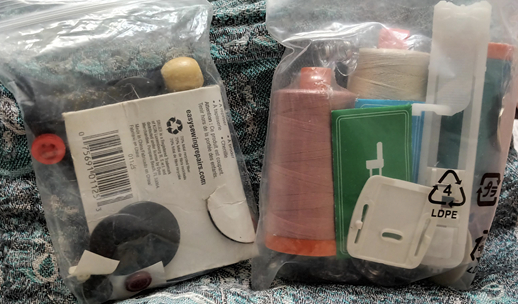 Thread and button collection |
| In terms of resizing clothes, it is often possible to downsize clothes that we buy or receive second hand with some stitches, either by hand or with a sewing machine. It can take some trial and error and may not always turn out right the first time, but I can attest to the fact that even a novice can mend clothes!
If we are trying to upsize the clothes, this may be possible, too, as there is often extra fabric included in clothing seams for this very reason. All the same, this task of upsizing may need a more experienced seamstress or tailor to help with, as it is more involved. Though we may be able to do many tasks with a needle and thread or a sewing machine, tailors are definitely our friends when it comes to repairing clothes! They can be very affordable, and also need business from time to time. |
|
Furniture When it comes to repairing furniture, a hammer, nails/screws, sandpaper, furniture brackets (like L-brackets), glue, a drill, and online search engines for ideas may all be useful tools to have on hand - and maybe a circular saw, if one is interested in trying out more involved furniture repair. If you’re fixing wooden furniture, an L-bracket and some screws drilled in may help attach furniture back together. You might need to sand off some rough edges to make the fix, and be willing to have a less than perfect piece. Wood glue and clamps, or epoxy glue for plastic furniture (more about this below!) can be helpful for gluing together wooden parts that have split. When we are fixing furniture, it’s important to consider why the piece broke, and how to ensure it is safe from breakage in the future. We had a wobbly, somewhat broken, small teak shower bench we bought used on eBay. It arrived unexpectedly broken. We fixed it up with some wood glue, and repurposed it as an outside stand with a bowl of water on top for the birds. Although originally not our plan, we were able to fix it up and find an appropriate use for it - though it would not have been strong enough to be a shower bench, it found a useful home outside! |
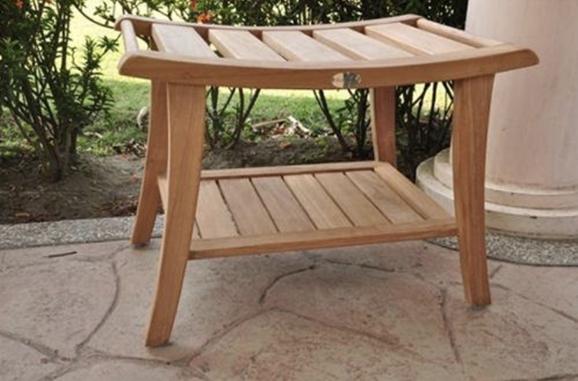 |
| Jewelry, Dinnerware, and Plastic
While stitches and screws may work for fixing up clothes and furniture respectively, for jewelry and plastic pieces not used for food or cooking, making repairs with epoxy glue could be one way to go. Epoxy glue is deemed food safe once fully cured. Some alternative glues to epoxy for food-contact items include aquarium-safe silicone. Aquarium-safe glues are generally very heavy duty and should hold. Another product that is really useful when repairing items is called Sugru. It is a moldable putty-type glue that hardens when dried. It can be used to repair many different materials. I have used it to repair sheathing around computer cables, patch a hole in my shoe and even repair a tear on the side of my car! The section between the arrows was completely disconnected and flapping around in the wind when I drove. A few packages of Sugru and a clamp, and the fix is barely noticeable. The product can be found at major Home Improvements stores and online. |
 |
| All the same, once you fix up an item, as mentioned above, consider its post-repair use - if you think it’s easy to break or aren’t so sure of your fix-up method, consider a less exacting use for it. Also, sometimes an item can still function just as well without being fixed up! We have a couple of mugs at home that have broken handles - it’s part of wear and tear sometimes! |
|
Plastic Containers It is inevitable that even with the best efforts, you may end up with takeout or packaging containers. I used a few of them when my plant needed to be repotted. It’s quite exciting to watch the plant grow new roots through the sides of the container. |
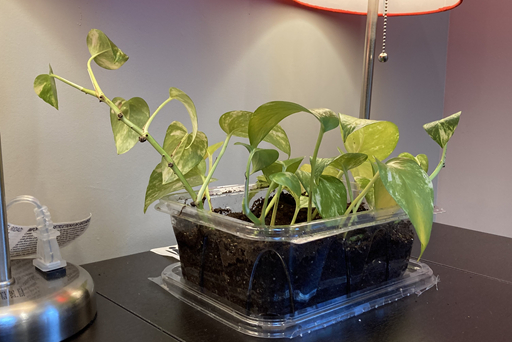 Plant in a take-out container |
| Renew items by Repainting Them
I had a pair of burgundy vegan boots I loved. They got scuffed up badly from wear and tear. I had a few tubes of acrylic paint which I mixed together to match the color of my boots pretty closely. Once or twice a year, I would paint my boots and they would be like new again until they finally fell apart beyond repair. I had a small carry-on suitcase that I got for a bargain because it was almost neon yellow. It was easy to spot on the carousel for sure. Over the years, it got really dirty looking from being tossed around on all my flights. I used acrylic paint again and gave it a new life. |
| General Ideas
I’ve recently been informed by another devotee that Repair Cafés are part of a cool new venture that exists in multiple countries, including the US. Many states in the US now have Repair Cafés where people can work together and use on-site tools, materials and expertise to repair items while bonding together. It is generally free to enter a Repair Café and fix things up. Find out if you have one nearby. Finally, budget permitting, let us also be willing to seek out tradespeople to help us fix broken items. Jewelry repair shops, tailors, electronics repair shops and more all exist, and the people who work there will certainly have creative solutions to help us repair and reuse the items we have on hand. Hopefully we will have many repaired items on hand to show Amma in our hearts, and in person over the next years to come! You could use your cosmetic and other containers to refill products from bulk stores. This website has lists of Bring Your Own Container (BYOC) stores in every state. However, due to COVID, most of them are most likely not accepting BYOCs. However, it can be a reference for the future https://www.litterless.com/wheretoshop Diksha, Maryland |
|
Disclaimer Any reference in this website to a specific product, process, or service does not constitute or imply an endorsement by GreenFriends North America or MA Center. |
Read the Embracing the Trees progress report in the Q4 2021 newsletter >>
| Home | Source Reduction | Friends of Green Friends | Newsletters | Resources | What You Can Do | Contact Us |
For more information, e-mail info@greenfriendsna.org |
||||||